Content
Delphiniums are rightfully ranked not only among the most spectacular flowering garden perennials, but also among the most representative plants in terms of varietal palette. Among the breeding forms of this plant, there are both novelties with a sensational color and size, and old varieties that do not differ in the massiveness of the inflorescences. But not all plants can boast of a set of all qualities so valued in delphiniums. After all, it is not so rare that the bushes simply fall apart, require constant rejuvenation, are overly sensitive to powdery mildew and are not able to bloom again. In order not to be disappointed in your favorite perennial and to admire the beauty of long candles from the beginning of summer to the end of the season, choose the varieties carefully.
Delphiniums
A reliable result can be easily ensured by exclusive hybrids and varieties that are rightfully considered the best:
Delphinium Ballkleid
A medium-sized and surprisingly resistant variety with a classic pale blue color, capable of demonstrating all the luxury of blue accents in the composition - this is the Bolklade delphinium, bred by Karl Forster. This cultivar is an improved hybrid from the Belladonna group.
Reaching a height of 120 cm, it stands out for its dense, very lush and dense foliage with unusually bright colors for delphiniums. The shoots of this variety are powerful, strong, slender, majestically rise above the beautiful foliage, the bushes perfectly retain their shape and do not fall apart even in places with an active wind environment. Delphinium shoots are crowned with tall and transparent, somewhat elongated and loose brushes, in which each flower of an elegant shape is clearly visible.
Delphinium Ballkleid
Flowers up to 2 cm in diameter in rather narrow inflorescences are painted in pale blue, light and, as if porcelain, decorated with a small light eye. This hybrid blooms throughout June and July, abundantly, and after carrying out elementary pruning of peduncles, it re-releases luxurious candles in September. It is considered one of the most hardy and disease-resistant varieties of delphinium.
Delphinium Atlantis
Very similar in all characteristics to the previous variety - only slightly lower delphinium "Atlantis". They are often called twin hybrids, because they are strikingly similar in terms of flowering, and in durability, and in the stability of the bushes, which always retain their density and integrity. But "Atlantis" also has unique features.
This delphinium is rightfully considered one of the rare in color. The ultramarine blue color, trusted to the absolute and surprisingly luxurious, despite the presence of almost indistinguishable shades and "erosion" on the flowers, is a unique sight in its purity. "Atlantis" is more squat, its height only approaches 1 m. But the number and size of inflorescences make it one of the most striking plants in the Forster collection. Elongated, long and delicate-transparent clusters of inflorescences seem weightless, and the dark, cold and rich color instantly attracts attention to them. Lush, dark greens in dense sods only reinforce the reputation of a reliable, brightly flowering variety.
Delphinium Atlantis
Delphinium Piccolo
Despite the rather short panicles of inflorescences, the impressive burgundy "Piccolo" is ranked among the most abundant delphiniums of the Belladonna group. It is a medium-sized variety, about 1 m or less in height, with strikingly airy, multi-blooming buds, the number of which on the bush creates a massive effect.
This is a special variety of low delphiniums. Cup-shaped flowers are very beautiful in and of themselves, they sit on unusually long and thin pedicels of the ascending type, due to which the clusters of inflorescences are originally loose, delicate, rather branched at the bottom. However, this Italian variety became famous not only for its absolutely pure sky-blue color and playful miniature white eye on each flower.
Delphinium Piccolo
Piccolo is distinguished by its ability to regrow very late. The first wave of flowering usually falls in June, while the last, with favorable weather, begins only in October. This view seems to be crowning the final touches of autumn flower beds. Despite the abundance of flowering, "Piccolo" has practically no drawbacks in terms of care requirements and the ability to bloom relentlessly from year to year.
Delphinium Berghimmel
The most reliable and durable high delphinium variety. The peduncles of this aristocrat rise to a height of at least 180 cm, although most often they exceed 2 m. Their beauty and splendor brought the variety the title of an elite representative of the Elatus delphiniums, the real pride of the Forster collection.
Delphinium Berghimmel
This garden giant blooms at the classic time, in early and mid-summer for the first time and no less luxuriantly in September and October after pruning. Simple, but very beautiful and bright due to the white eyes, blue flowers reach 5 cm in diameter and are collected in practically non-tapering panicles of at least 20 pieces. Despite the height and power of flowering, the bush never loses its integrity.
Garden classics are not only about plants that can be found in almost every garden. First of all, these are magnificent crops that have proved their endurance, unpretentiousness and resilience over the decades. One of the traditional perennials, which does not prevent the status of the old one from being included in the ratings of the most fashionable garden crops from year to year, is the delphinium.
A stately giant with amazing openwork inflorescences of very beautiful flowers today does not at all resemble a plant with only one color variation - blue-violet. A tall, noble and graceful delphinium that brings verticality to flower beds always looks advantageous. True, caring for him should be thorough enough.
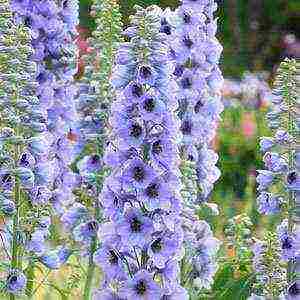
Delphiniums are by far the most popular tall flowers. In height, these beauties can reach 2 meters, while all types of delphinium have an erect, vertical stem, crowned with an inflorescence.
Charming large delphinium inflorescences bloom in summer, from late June to September, gradually revealing flowers of a very graceful shape, collected in dense candle-like inflorescences. A hollow process is formed on the upper petal of the flower, known as a small spur, due to which the people often call delphiniums a spur rather than a scientific name.
The color gamut of delphiniums today is much wider than the palette of blue. All possible variations of purple, blue are complemented by white and pink colors.
Delphinium varieties
The range of delphinium varieties seems immense. In addition to generally recognized perennials, among the new varieties, especially original in color, there are also plants that actually die after the very first winter. When buying these plants, you should carefully choose exactly perennial varieties that will retain their decorative effect for many years.
Today, only hybrid varieties of delphiniums are actively used in gardening.They are usually divided into separate groups - Pacific hybrids, the Belladonna and Elatum groups, the Magic-Fountain, New Millenium, and Guardian series. Let's take a closer look at them and the best varieties of delphiniums.
Elatum
The Elatum group unites the highest delphiniums. These two-meter giants usually need a support even before flowering - a ring with a rod that will prevent the wind from breaking the plants. In one place they are able to grow up to 10 years, but the splendor of flowering is maintained under conditions of transplantation every four years with a corresponding division of the bush.
The best varieties of this group are the charming pale blue variety Augenweide, Finsteraarhorn with a rich purple color and Sungleam with creamy yellow, large semi-double flowers, slightly similar to the mock-orange.
Belladonna
One of the longest-flowering groups is considered to be "Belladonna", which unites delphiniums from 80 to 120 centimeters high with delicate, beautiful textures of almost cylindrical inflorescences. Usually, all varieties of this group are distinguished by more rare, friable inflorescences that do not seem so massive and are perceived as more delicate.
The classic representative is the "Piccolo" variety with a bright blue color, which looks very gentle and lyrical, and the "Ballkleid" variety with blue flowers with a white "eye", which seems sophisticated and watercolor.
Pacific hybrids
Pacific hybrids are spectacular, bright varieties that, unfortunately, retain their decorative effect for no more than 3 years. At a height of one and a half meters, with very exotic, fresh colors of flowers, these delphiniums stand out with large, seemingly tropical flowers. Some of the best varieties of the group are pink-colored "Galahad" up to 2 meters in height with large snow-white almost double flowers and "Astrolat" with simple cupped pink flowers.
Magic-fountain
Equally short-lived are the representatives of the Magic-Fountain group, not growing more than 80 centimeters, with powerful stems and very showy flowers with a prominent bracts core. One of the most beautiful varieties - "Astrolat" with pyramidal dense pink inflorescences of densely sitting, with a spectacular core of flowers. They are usually sold as a mixture of variegated varieties.
New millenium
Delphiniums of new (conventionally, of course) series can boast of smaller growth and larger flowers. In particular, spurs from the New Millenium group do not exceed one and a half meters, they adorn with very dense and lush candle-shaped inflorescences, mainly from double flowers.
The charming terry varieties of delphinium are distinguished not by the splendor of the flowers, but by the unique fringed edge. They look more elegant than the classic varieties and seem to be real aristocrats. Picturesque terry species of complex color are usually distinguished by larger inflorescences.
The best varieties include Dusky Maidens, which has very strong erect stems and can be used for cutting.
Guardian
Representatives of the Guardian series are generally limited to one meter in height. One of the most beautiful relatively new varieties is "Guardian Blau" (Gardian Blau) up to 1 meter high, the flowers of which are not only very rich in color, but also surprisingly luxurious: large, with prominent petals, in the middle they are decorated with a bunch of small white bracts ... Representatives of the last two groups are excellent for cutting.
Growing features
Delphiniums are very demanding on growing conditions. They need not only slightly moist and humus-rich soil, but also sunny areas. Before planting delphiniums, compost should be additionally added to the soil, and after planting it should be mulched with sawdust, bark, or plants that shade the soil should be planted.
Delphiniums are fed twice a season: in the spring, by applying a complex fertilizer, and in the fall, after pruning, by adding phosphorus mixtures. Delphiniums need protection from slugs.
Most delphinium varieties are capable of blooming twice a season. To stimulate the delphiniums to re-bloom in autumn, cut the plants immediately after the first wave is complete, leaving stems about 25 centimeters high.To avoid rotting, the sections are covered with clay, phosphorus fertilizers are introduced into the soil and mulched with rotted compost. Until autumn, new shoots will grow on the plants, which will have enough strength to form new flowers.
Use in garden design
In landscape design, delphinium is used for group plantings, in particular, as a flower bed or for compositions in a modern style. Delphinium is good both in spacious flower beds and in decorative small ensembles. High varieties of delphinium can be planted only in the background, while medium and low-growing ones are sometimes even located in the foreground.
It is believed that delphinium is combined with almost all annuals and perennials, however, with one condition: partners can be contrasting in growth forms, but not in height. Neighboring plants should be of the same height or slightly less than the bristle itself.
It is quite easy to find partners for the delphinium. In particular, it pairs well with oak sage, which also has long flowers, but much smaller and thinner ones, or with whorled sage, which is also prone to re-flowering after pruning, during which time it releases curved inflorescences with spider-like clusters of small flowers.
If you want a classic combination with a high crop with a completely different type of flowering, pay attention to small-grained geranium or gypsophila paniculata, which exquisitely emphasize the flowering giants.
For the role of a modest, but surprisingly openwork partner of delphiniums, you can also choose valerian officinalis and fennel, whose white and yellow, respectively, umbrella-shaped inflorescences will gladly replace the classic and more massive yarrow, which are considered traditional neighbors along with the cornflower and small petal. Original combinations can be obtained by planting delphiniums together with feather grass, reed grass, coreopsis, cuff.
Did you like the article? Add it to your bookmarks by clicking the button of your favorite social network:
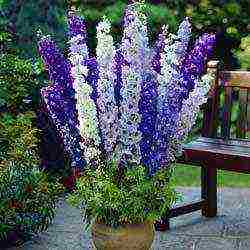 Delphinium is a rather unusual plant that always stands out against the background of most due to the impressive growth and incredible beauty of its flowers. Many gardeners dream of growing this giant in their garden, which is pretty easy. Nevertheless, certain subtleties in this process are still present. Today you will get acquainted with the best varieties of perennial delphinium, as well as learn everything about the features of its planting, as well as about the care and control of pests (photo instructions for plant care are attached for review).
Delphinium is a rather unusual plant that always stands out against the background of most due to the impressive growth and incredible beauty of its flowers. Many gardeners dream of growing this giant in their garden, which is pretty easy. Nevertheless, certain subtleties in this process are still present. Today you will get acquainted with the best varieties of perennial delphinium, as well as learn everything about the features of its planting, as well as about the care and control of pests (photo instructions for plant care are attached for review).
Perennial delphinium: description, characteristics of the best varieties
Delphinium is a plant of amazing beauty and resilience that belongs to the Buttercup family and for many years has been "looking" at the world with wide-open eyes of its luxurious petals of blue, white or purple. The plant can reach a height of 2 m and currently has more than 800 varieties.
The plant has a rather powerful peduncle, on which there is a dense armful of flowers, collected together in the form of a pyramidal shape. Inside almost every flower there are several petals of a darker shade than all the others.
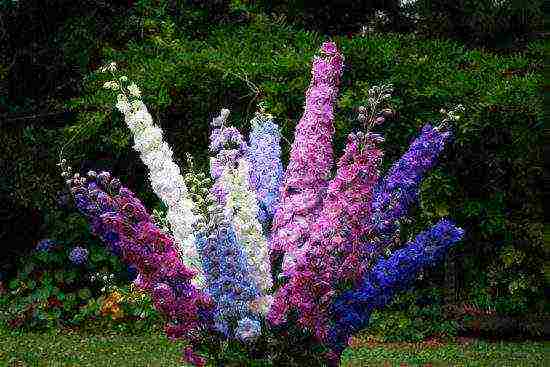
There are many varieties of delphinium
Among the variety of varieties of delphinium, you can find terry, and super-double, and dwarf, and gigantic, etc. Originally, the perennial plant was cultivated on the basis of one of two species: Delphinium large-flowered / tall. Over time, the first hybrids were bred. Today, you can find about 800 different varieties of delphiniums, each of which belongs to one of 5 main categories:
- Marfinsky hybrids.Although this category of delphinium is called hybrid, almost all representatives of this species retain the characteristics of their parents by 80-90%. Outwardly, they are represented by plants of rather impressive sizes - 1.7-2 m. The "highlight" of the species is the appearance of the bush: it is quite strong, tall (about 1.7-1.8 m, some specimens reach 2 m in height) and dense with semi-double flowers of a delicate shade.
- Belladonna. The original subspecies of delphinium. The only one presented in the list has a "drooping" type of inflorescence (panicle).
- Elatum. Unlike other varieties, this one is distinguished by the presence of flowers of similar shades in almost every plant (ranging from pale blue, almost transparent to rich lilac and purple shades).
- Pacific hybrids are distinguished by gigantic growth (almost all of them reach a height of about 2 m) and large dense semi-double inflorescences.

Elatum
Among the huge variety of delphinium varieties, it is quite difficult to single out units, but, perhaps, you can dwell on a few of the brightest.
- Snow lace. The plant has a delicate delicate aroma. The bushes grow medium in height - about 1.5 m, and the length of the peduncle is slightly less than half a meter. The variety has unusually delicate white flowers, distinguished by a luxurious appearance. It blooms very quickly and luxuriantly.
- Princess Caroline. It is considered one of the most aesthetically pleasing delphinium varieties. The plant is considered a giant: its stem reaches 2 m in height, flowers in diameter can reach 10 cm.The petals are painted in a delicate pinkish color.
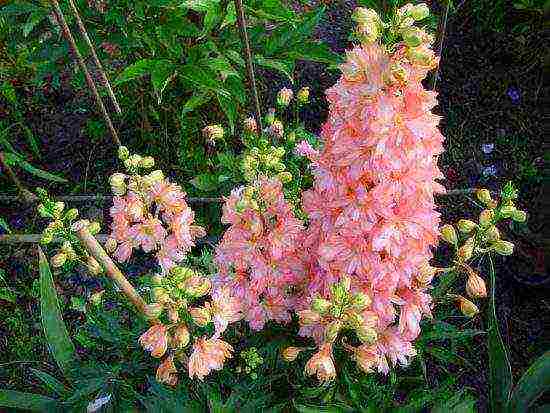
Princess Caroline
- Pink butterfly. The variety is distinguished by rather low bushes: the stem reaches a maximum of 1 m in height. But the variety blooms with rather unusual bright pink flowers, which, when blooming, resemble a flying butterfly. The plant is extremely popular among landscape designers, who use it mainly for padding tall bushes and trees.
Delphinium breeding methods
This process can be done in several ways. Let's consider each of them in detail. So, if you are planning to replant the plant, and it has already been decorating your garden plot for about 3 years, you can plant a delphinium by dividing the bush. To do this, in early spring, when the bushes are not yet very tall (no higher than 15 cm), you need to carefully dig out one of them and divide it into several parts.
Advice. In order for the delphinium to take root well in a new place, try to carry out the division in such a way that at least 1 shoot remains on each separate part of the rhizome.
First of all, remove all damaged parts, clean the rhizome from the remnants of the earth and rinse it thoroughly with warm water.
Carefully lower the divided parts into containers with a prepared soil mixture consisting of sand, humus and black soil in equal proportions. Sprinkle the planted parts with earth and send them to a warm place for a couple of weeks (no longer, since the transplanted sprouts take root very quickly). After this period, you can land in open ground.
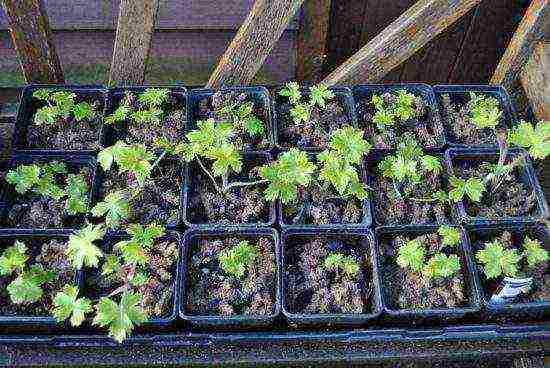
Delphinium seedlings
Reproduction by cuttings is also carried out in early spring. It is necessary to cut off 10-centimeter shoots so as to capture part of the rhizome. The resulting cuttings can be safely planted directly into the open ground, and after a couple of weeks moved to the garden.
Advice. Remember: in order for the cuttings planted on the site to quickly take root and immediately grow, they must be regularly sprayed with water (several times a day).
Well, and finally, seed propagation. To do this, you need to prepare them ahead of time (even in the fall). Keep in a cool place. You can start planting seeds with the onset of the first days of spring.Seeds are sown in a container with a prepared soil mixture, consisting of the same components as in the reproduction of a delphinium by division.
The seeds are lowered into the prepared shallow grooves at a distance of about 6 cm from each other, sprinkled with a thin layer of earth, which should be slightly moistened with a spray bottle.
Outdoor cultivation
As for planting a delphinium and caring for it in the open field, this process is not so complicated, nevertheless, certain nuances are present here.
Soil preparation and planting
Choosing a place suitable for a delphinium should be very careful, since the plant loves the sun very much and reacts negatively to wind and strong shade. Therefore, for planting, choose a sunny, warm place with minimal access to wind and shade (but for 2-3 hours a day, the shadow should still be present over the area where the flower is planted, otherwise it may simply get burned).

Delphinium is frost resistant
Delphinium is absolutely not afraid of frost (it is able to withstand even -30 degrees), therefore, it will perfectly take root even in the most severe climate.
Attention! Delphinium has a fairly powerful root system located close to the surface. For this reason, in no case should you choose a place in which large glades appear in spring as a planting site - the rhizome can simply dry out.
Delphinium is very fond of fertile and fairly light neutral / slightly acidic soil, but at the same time it feels confident enough on loam if it is fertilized correctly. For these purposes, you can use peat, humus, etc.
With the onset of autumn, the area for the delphinium should be dug onto a shovel bayonet and fertilized with a peat-manure mixture. In the spring (just before planting), the soil is re-dug up, and potassium salt and superphosphate are added to it in an amount of about 60 g, as well as ammonium sulfate (about 40 g).
Now you can start preparing the holes. Their depth should be about 0.5 m, and the distance is chosen individually (it all depends on the size of the variety chosen for planting). Part of the soil from the hole is mixed with compost and sent back. When it settles (after a couple of days), you can plant the plant in the way that is most optimal for you.
Features of delphinium care
This process is simple enough, but it should be done on a regular basis. The main thing is to water the plant on time, provide it with nutrients and periodically thin it out, because the thicker the delphinium grows on the site, the smaller it will be.
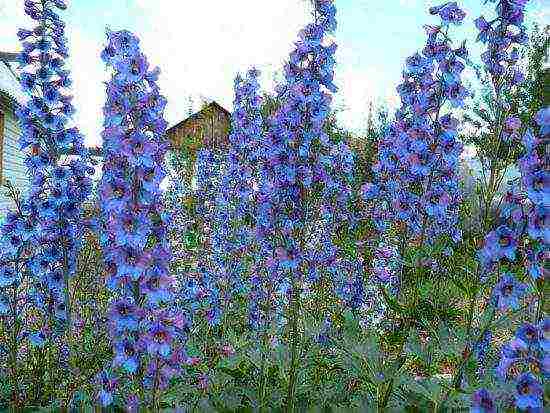
Delphinium needs to be fed
As for dressings, there should be at least 3 of them per season:
- The first is carried out in early spring. A mixture of ammonium nitrate (15 g), calcium chloride (30 g), superphosphate (70 g) and ammonium sulfate (40 g) is poured under the bush and slightly deeper into the ground.
- Secondarily, the delphinium is fertilized during the period when a large number of buds appear. This time, the plant should be fed with a mixture of potassium and superphosphate (each element in an amount of 40 g).
- The third time, use the same mixture as the first. Plant feeding is carried out approximately at the end of August.
Disease and pest control
Delphinium is a beautiful plant that lives in one place for up to 10 years, but, unfortunately, is highly susceptible to various diseases. Further about what diseases and pests the delphinium most often "suffers" from and how to protect it from them:
- Powdery mildew. White-gray bloom that appears on the surface of the leaves. Over time, the damaged leaves darken and die off completely. Control method: with gas sulfur (1%), it is necessary to spray the plant until the symptoms of the disease are eliminated.
- Downy mildew. Yellowish spots on the visible side of the leaf, white bloom forms on the back. Method of struggle: thin out the bushes and spray with Bordeaux liquid (1%).
- Black spot of leaves. Black spots on the visible side of the leaf, gradually covering the entire leaf and passing to the stem. Method of struggle: spray the root collar with 1% mercuric chloride, and after a while - with Bordeaux liquid.

Delphinium on a flower bed
- Ring spot. Patterns of yellow color on the leaves. Control method: removal of diseased plants from the site and careful adherence to agricultural techniques for growing a flower.
- Slugs. This pest loves to feast on young juicy delphinium sprouts. You can eliminate the "threat" by regularly thinning the bushes and loosening the soil on the site. You can add potassium salt under each bush.
On this, our acquaintance with the peculiarities of growing delphinium in the garden comes to its logical conclusion. Now you know how to grow a beautiful and healthy plant in your garden. Good luck!
Growing a delphinium: video
Delphinium Is a beautiful plant of the buttercup family. The flower can be of different heights (from 40 cm to 2m), annual and perennial. Various coloration of large inflorescences (up to 80 cm in length) will add originality to any garden.
For some varieties of delphiniums, one feature is characteristic - inside the inflorescences there are 2 (sometimes more) petals, in color contrasting with the main shades of the petals. They are called eyes.
Delphinium varieties there are a lot - there are about 400 of them. Each of them differs in the structure of the plant, its appearance and color. Consider the most popular large-flowered delphinium hybrids in our country.
New Zealand delphinium hybrids (New Millennium)
In recent decades, a whole series of New Zealand varieties have been developed, which are characterized by excellent frost resistance, unpretentious care and long flowering. For our climate, New Zealand delphiniums are an excellent option for decorative decoration of a suburban area.
Height - 1.5-2.2 m. Inflorescences - terry or semi-double, 80 cm in length, collected in brushes, dense, large, 4-6 rows of petals on one. The size of each is up to 9 cm in diameter. The color of the plant can be very different.
The most popular varieties of the New Zealand delphinium:
Pacific hybrids (Giant Pacific)
This class includes perennial delphiniums with a rather high (120-180 cm) erect stem. Inflorescence type - large candles (up to 100 cm), semi-double, in different shades. The size of each individual flower is up to 7 cm in diameter.
The main disadvantage of Pacific delphiniums is their short lifespan (no more than 5 years). In addition, in the Russian climate, they are often susceptible to diseases, therefore, they require careful personal care.
The most attractive and resistant to adverse conditions varieties of Pacific delphiniums:
Belladonna hybrids
The varieties of delphiniums of the Belladona group are formed by large-flowered and labiate species of this plant. Representatives of this class are characterized by branched paniculate inflorescences (5-20 flowers each) and dissected leaves. Bloom, as a rule, closer to mid-July.
The most famous varieties of Belladonna hybrids:
Marfin hybrids
Delphiniums of this class are in great demand among flower growers (these are Russian varieties), since they are perfectly adapted to the conditions of our climate. In terms of quality and decorative indicators, they are in no way inferior to their foreign counterparts. Delphinium varieties belonging to this class form neat bushes reaching 180 cm. Large inflorescences are in the form of a pyramid, with semi-double flowers of different colors.
Quality varieties of Marfin hybrids:


